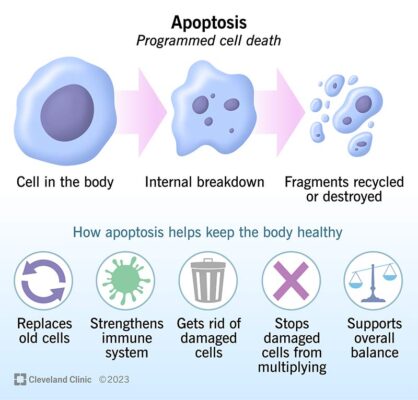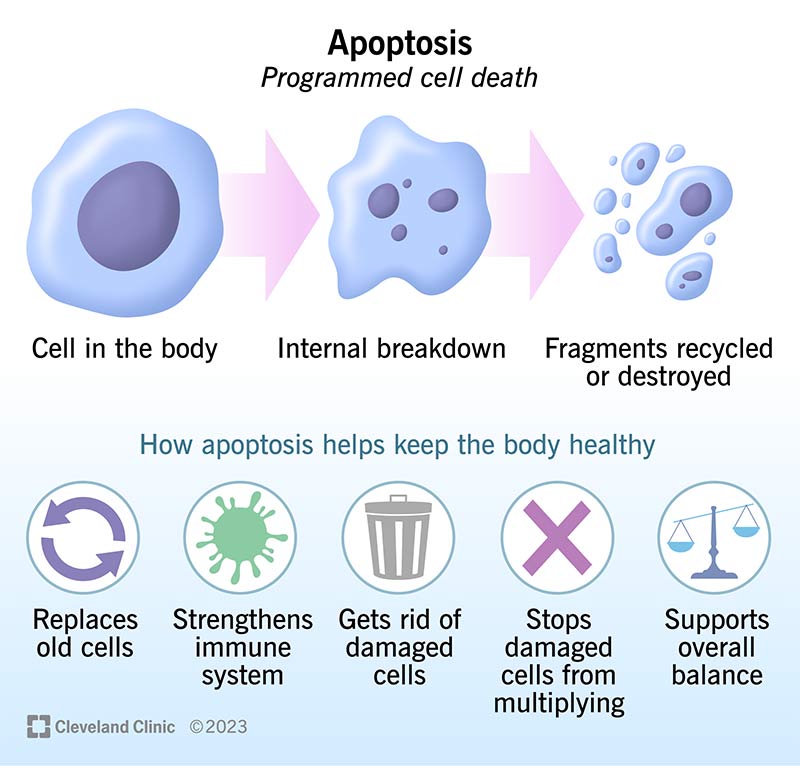Apoptosis is a process of programmed cell death, where cells intentionally undergo a controlled death in response to specific signals. Unlike necrosis (which is an uncontrolled form of cell death often due to injury or damage), apoptosis is a natural, orderly process that is essential for the normal functioning of an organism.
Purpose of Apoptosis:
- Development and Growth:
- During embryonic development, apoptosis plays a crucial role in shaping organs and tissues. For example, apoptosis helps in digit formation by eliminating the cells between developing fingers and toes, allowing the formation of a distinct hand or foot.
- It is involved in tissue remodeling during growth, eliminating excess or unwanted cells and helping maintain proper structure.
- Maintaining Cellular Homeostasis:
- Apoptosis helps maintain a balance between cell division and cell death. This process ensures that the number of cells remains balanced and prevents overcrowding or the accumulation of old, damaged, or malfunctioning cells.
- It prevents the growth of abnormal or damaged cells that could otherwise lead to diseases, including cancer.
- Eliminating Damaged or Infected Cells:
- Apoptosis acts as a protective mechanism to remove damaged cells that may have undergone genetic mutations, preventing them from proliferating and causing cancer.
- It also helps in the elimination of virus-infected cells. When cells are infected by viruses, apoptosis ensures that the virus doesn’t replicate and spread to neighboring cells.

- Immune System Regulation:
- In the immune system, apoptosis is involved in eliminating immune cells that are no longer needed, or that could attack the body’s own tissues, as in autoimmune diseases.
- It also helps in maintaining tolerance to self, removing potentially harmful immune cells that might target the body’s own cells.
- Prevention of Tumor Formation:
- By eliminating damaged or mutated cells that could otherwise divide uncontrollably, apoptosis is considered a defense mechanism against cancer. It ensures that cells with DNA damage do not accumulate mutations that could lead to tumor formation.
How Apoptosis Works:
Apoptosis is a highly regulated process and involves several key steps:
- Signal Activation: Apoptosis can be triggered by both internal signals (such as DNA damage, oxidative stress, or malfunctioning proteins) or external signals (like signals from the immune system, or death receptor pathways).
- Cell Shrinkage and DNA Fragmentation: Once the apoptosis process begins, the cell starts to shrink and break down its components. The DNA within the cell undergoes fragmentation into smaller pieces.
- Formation of Apoptotic Bodies: The cell breaks apart into small membrane-bound pieces called apoptotic bodies, which are then engulfed and removed by nearby cells, such as macrophages.
- Phagocytosis: These apoptotic bodies are consumed by phagocytic cells (like macrophages), which helps to clean up the remains of the cell without triggering an inflammatory response.
Importance of Apoptosis:
- Prevents Cancer: Apoptosis helps protect the body from the development of cancer by eliminating damaged or mutated cells that might become cancerous.
- Regulates Immune Responses: It ensures that immune cells that are no longer needed, or that might be harmful to the body, are cleared away.
- Embryonic Development: Apoptosis is involved in forming complex structures like organs and limbs by eliminating unnecessary cells.
In summary, apoptosis is a fundamental biological process with the vital purpose of maintaining health, development, and homeostasis. Its failure can result in severe diseases, including cancer, autoimmune disorders, and developmental abnormalities.

